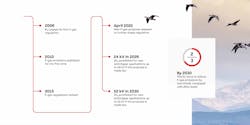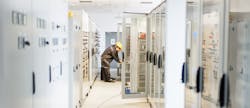The increasing development and deployment of technologies such as energy storage and smart grids, has huge potential to reduce societies’ reliance on fossil fuels by integrating more renewable energy sources into electricity systems, but there is another equally important aspect of electricity distribution that needs to be tackled alongside this: F-gases.
This family of synthetic gases, which were developed in the late 1920s, are used in essential industrial applications such as refrigeration, air-conditioning systems and fire protection. Most notably, however, one of these gases, sulfur hexafluoride, or SF6, is an extremely popular electrical insulation system for power systems. It is also widely used for current interruption in the transmission and distribution of electricity. In other words, its unique physical properties make it crucial to the reliable operation of many electricity systems around the world.
The fact that it is a very stable chemical with an atmospheric lifetime of 3,200 years means that even if its usage is reduced, there will still be a substantial build-up of the chemical in the atmosphere.
Migration Gathers Pace
It is hardly surprising, then, that as soon as regulators realized the enormous environmental impact of F-gases, steps were taken to reduce its use. Calculating that cutting F-gases could add up to cumulative emissions savings in the region of 1.5 gigatonnes of CO2 by 2030, legislation was quickly drawn up to limit its use.
In 2006, the European Union (EU) passed its first F-gas regulation, a move that stabilized EU F-gas emissions four years later. These were then revised in 2015, setting a new deadline of 2030 for cutting the region’s F-gas emissions by two-thirds compared to 2014 levels. With a fixed goal in site, migration towards a more certain SF6-free future gathered pace. And this shift is now set to accelerate even more rapidly, since a new proposal was submitted in April 2022, stipulating that the use of SF6 in MV switchgear will be prohibited from 2026 for applications up to 24kV and from 2030 for applications up to 52kV.
Operators in the electricity distribution sector would be wise to start thinking about their journey towards specifying switchgear free from SF6 now. Not only will developing a migration strategy and testing SF6 -free solutions boost their environmental credentials sooner, something that is increasingly important both from a regulatory and consumer perception standpoint, but it will also help them avoid rushed purchasing decisions and installations later on.
Test, Then Implement
Some organizations and network providers are already starting the shift, trialing SF6 -free alternative switchgear in small pilot projects, which have minimal impact on their wider operations.
We are seeing a notable increase in network providers and organizations trialling a number of different SF6-free switchgear in well-controlled environments that are easy to analyse over the course of 12-months or more.
ABB’s MV ecoGIS switchgear is one option being trialed. It uses AirPlus technology as an alternative insulation gas to SF6, without compromising performance, safety or reliability. Retaining the compact footprint of SF6 switchgear, AirPlus has a GWP of <1, compared to the GWP of SF6, which is 25,200. The revolutionary double busbar design gives the benefit of reliability by reducing the risk of unplanned downtime and offering flexibility in sharing the power load.
The most important part of these product pilots is to ensure the SF6-free alternatives perform as well as the switchgear they will be replacing. Engineers will usually conduct regular inspections throughout the pilot to identify any abnormal working conditions such as loss of pressure. There are of course other factors
to consider such as cost, ease of installation, product availability and customer support.
From Pilots to Volume Specification
As part of its Environmental Action Plan to pass on a sustainable planet for future generations, the UK’s biggest electricity distributor, UK Power Networks, is one organization that is using AirPlus at its substation in Kent.
Barry Hatton, director of asset management at UK Power Networks, said: “We have clear goals to reduce the environmental impact of our operations and help enable the country’s transition to net zero carbon emissions, while maintaining reliable electricity supplies for more than eight million homes and businesses. Our new AirPlus switchgear supports our strategy and delivery of our Environmental Action Plan.”
We anticipate many more providers following suit, not only testing SF6 for pilot projects but specifying the new technology on a much larger scale. Now the legislation is drawing closer, we are seeing more organizations begin volume-specification of SF6-free GIS, but some are still waiting for the legislation deadlines to be agreed. Working with the most experienced suppliers and embedding your volume specification of SF6-free GIS once your pilot is complete will put you in a better position to comply with the regulatory changes, once they come into effect.
By restricting the use of F-gases, the industry could achieve emissions savings in the region of 5 gigatonnes by 2050, the equivalent of more than the CO2 produced by a billion return flights from Paris to New York and more than the sum of all the greenhouse gases emitted in the EU, during one year. These projections cannot be ignored and will only be achieved if organizations start thinking seriously about SF6-free switchgear now. To secure our transition to a more sustainable future, now is the time to act and consider plans to reduce use of F-gases.
Next Steps
Demonstrating its commitment to accelerating the phase out of this greenhouse gas, ABB introduced its first SF6-free MV GIS solution to market in 2015 with an open patent, so that the technology was available for everyone to use.
Now, the ecoGIS portfolio is the most complete in the industry covering the whole range up to 40.5kV. The low-pressure design based on AirPlus for solutions above 12kV ensures highest availability and reliability of the network, while at the same time offering a similar footprint and design compared to SF6 switchgear, which allows for easy replacements or additions.
Since 2015, ABB has collaborated with partners and customers around the world to accelerate climate action through SF6 alternatives, and to date has sold over 9,000 sustainable SF6-free switchgear units that are performing successfully around
the world.
To download a whitepaper on this specific topic, you can visit ABB's site:
https://campaign.abb.com/ecogiswhitepaperpr
Maik Hyrenbach is senior principal engineer for Medium Voltage GIS at ABB. A recognized expert in GIS design and member of the ABB international team of experts for medium voltage technology, Maik has been published and worked toward alternative insulation gases, including sulfur hexafluoride, air and nitrous oxide. He is based in Ratingen, North Rhine-Westphalia, Germany. He graduated from the University of Duisberg in 1995 with a PhD in engineering.




